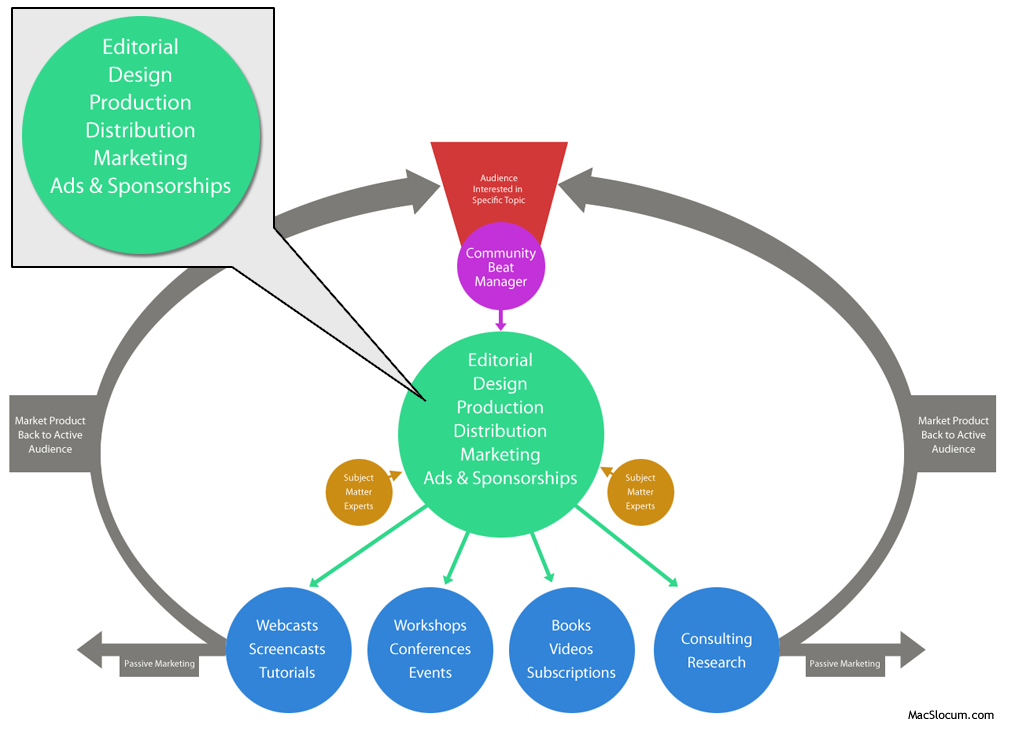The in-house editorial group has the hierarchical structure of a traditional publishing organization, with one key difference: it engages in ongoing communication with third-party community beat managers. This open channel allows the group to create for-pay products that directly address audience needs (see the "For-Pay Products" section). The group then markets these products back to core audiences through its blogs, social networking groups, Twitter, and other Web-based platforms.
This group also manages advertising and sponsorship opportunities and it oversees all of the traditional business functions: human resources, legal, taxes, contracts, permits, office space, etc.
In-House Editorial Group Roles
The roles outlined below define the various responsibilities of the in-house editorial group. Specific jobs will likely incorporate duties across the company (e.g. a single product manager may oversee multiple product types depending on the size and needs of the business).
| In-House Editorial Group Sample Hierarchy | |||
| Publisher | |||
| Editorial Director / Community Liaison | |||
| Print Manager | In-Person Event Manager | Online Product Manager | Research Manager |
Publisher: The publisher crafts the organization's long-term business strategy and evangelizes the company. Duties include: examining the current and future state of the industry, forging relationships with a variety of partners, and providing vision, guidance and a clear structure for the organization.
Editorial Director / Community Liaison: The editorial director oversees all editorial decisions and projects within the in-house editorial group. He/she also speaks with each of the community beat managers on a weekly basis to discuss the latest interests and needs of the target audiences. The editorial director uses this information to facilitate product development with each of the managers. Reports to: Publisher.
Print Manager: Responsible for editorial oversight, project management, production and distribution of all for-pay print products. Reports to: Editorial Director.
In-Person Event Manager: Responsible for oversight, management, logistics and marketing for the organization's in-person workshops, conferences, classes, and meet-ups. Reports to: Editorial Director.
Online Product Manager: Responsible for oversight, management and marketing for the organization's in-depth online products, including webcasts, online conferences, and community efforts. This manager is also the technical point person for the organization's blogs, Web sites, and social networking platforms. (Note: The editorial and technical duties of the online product manager could be spread across two positions). Reports to: Editorial Director.
Research Manager: Responsible for oversight, management and marketing for the organization's research reports, database projects, and market analysis products. Reports to: Editorial Director.
Assistant editors may be necessary if an organization targets multiple communities. Roles include:
- Assistant Print Editor: Handles production and editorial work for print products and coordinates future projects with the print manager.
- Assistant In-Person Event Editor: Handles logistics, organization and administration for workshops and conferences and coordinates future events with the in-person event manager.
- Assistant Online Product Editor: Handles editorial, production and implementation of online products and coordinates future initiatives with the online product manager.
- Assistant Research Editor: Handles the editing and production needs of the research group and coordinates future products with the research manager.

Leave a comment